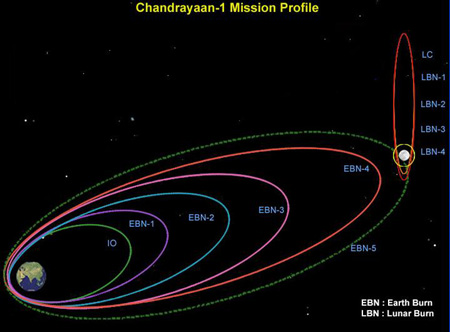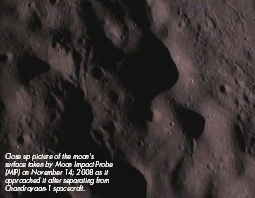|
Bangalore. India’s space scientists celebrated the birthday of the
country’s first Prime Minister on November 14 in style by landing the Indian national
flag on the moon in a climax to a 22-day mission that galvanized the whole nation.
“It was the most appropriate way to remember Jawaharlal
Nehru,” remarked Gopalan Madhavan Nair, Chairman of the Indian Space Research
Organization (ISRO) in Bangalore. The architect of modern India, Nehru was
the first political leader to realize that India needed science and technology
– including space technology – to emerge from years of colonial rule.  After
circling the moon for six days ISRO’s Chandrayaan-1 spacecraft dropped the
34-kg Moon Impact Probe (MIP) with the orange, white and green Indian flag painted
on its sides – at a place near the moon’s south pole where water, if
present, is most likely to be found (see box). After
circling the moon for six days ISRO’s Chandrayaan-1 spacecraft dropped the
34-kg Moon Impact Probe (MIP) with the orange, white and green Indian flag painted
on its sides – at a place near the moon’s south pole where water, if
present, is most likely to be found (see box).
“We have delivered the
Moon to India,” an exultant Nair, told reporters rather poetically in Bangalore
minutes after the probe hit the designated spot on the Moon with calculated precision. Chandrayaan-1’s
nearly 380,000 kilometer journey that began October 22 from the Satish Dhawan
Space Centre in Sriharikota in southern India had gone amazingly well considering
it was the first time that ISRO had sent any object that escaped earth’s
gravity. The thud could not be heard in the rarified atmosphere of the moon.
And because of the light weight of the probe, the plume kicked up by its impact
was too faint to be seen from earth’s observatories. But the message
sent by the impactor was loud and clear: Indian scientists are not just earth-bound
anymore, but are ready to venture into the universe beyond the boundaries of the
planet earth. The successful mission also sent another important message
to the world. It has proved that neither giant rockets nor big budgets are needed
to go to the moon. The rocket that delivered Chandrayaan-1 at the Moon is
a pigmy compared to its giant cousins that the US, Japan and China had used for
such missions. And ISRO's budget for Chandrayaan-1 – about $ 85 million
including $25 million for the ground antenna (see box)— is a fraction of
what Japan spent on its lunar probe Kaguya ($480 million) launched last year,
or what the US has budgeted ($491 million) for its Lunar Reconnaissance Orbiter
(LRO) to be launched March 2009.  Money
was no problem for ISRO as much as the technical challenges posed by Chandrayaan-1
mission. The real challenge was to choose an ideal trajectory to reach the moon
given the payload limitation of ISRO’s Polar Satellite Launch Vehicle (PSLV). Money
was no problem for ISRO as much as the technical challenges posed by Chandrayaan-1
mission. The real challenge was to choose an ideal trajectory to reach the moon
given the payload limitation of ISRO’s Polar Satellite Launch Vehicle (PSLV).
The
PSLV had been used to send satellites to low earth orbits but never used for planetary
missions. It is not as powerful as Japan’s H-IIA or China’s Long March-3A
that sent Kaguya and Chang’e-1 to the moon, or the Atlas- 401 that will lift
NASA’s Lunar Reconnaissance Orbiter sometime in March 2009 from Cape Canaveral
in Florida. Significantly, after considering available options ISRO decided
on an elliptical parking orbit around the Earth as the best solution for the Indian
Moon Mission, instead of the traditional “direct transfer” used by all
lunar missions from the 1960s to the 1980s. “Direct transfer would
have required an additional stage to PSLV,” says ISRO scientist V Adimurthy
at the Vikram Space Science Centre where the rocket was built. Therefore
the ISRO team was forced to add more propellants to Chandrayaan-1’s onboard
engine enabling it to reach the lunar orbit on its own thereby avoiding an additional
stage to PSLV. The mission then had both solid and liquid propellants. Development
of the spacecraft bus too posed problems due to space, weight and power constraints,
according to V R Katti of ISRO Satellite Centre (ISAC) in Bangalore where Chandrayaan-1
was assembled and integrated with payloads. The challenge was in accommodating
the 11 different payloads in specific location and orientation in a small spacecraft
of the size of a domestic refrigerator. So, ISRO’s emphasis was on miniaturization
and use of lighter materials. Though a relatively latecomer to the Moon,
India has rightly chosen on its very first mission to focus on Moon’s polar
regions. Most other missions including the Apollo landings had focused on the
equatorial region of moon. Only now has the focus of NASA shifted to the polar
region as a potential place for finding water and setting up a beachhead. ISRO
says that the primary objective of the November 14 landing of the impactor was
to qualify the technologies required for landing Indians on the moon – sometime
possibly around 2015.  With
the crucial phase of the mission now over, the attention of ISRO has now turned
to Chandrayaan-1’s precious cargo – a suite of remaining 10 instruments
from six countries. With
the crucial phase of the mission now over, the attention of ISRO has now turned
to Chandrayaan-1’s precious cargo – a suite of remaining 10 instruments
from six countries.
There were 11 instruments on board: India (5), US (2),
UK (1), Germany (1) Sweden (1) and Bulgaria (1). Of these, the Made in India MIP
now rests on the moon’s surface after sending valuable pictures and data
during its 25 -minute descent. ISRO scientists agree that the real success
of the Chandrayaan-1 mission depends on what data it sends and how it helps to
advance man’s knowledge about the moon. Notably, India’s former
President Dr A P J Abdul Kalam, a space and missile scientist, has suggested that
mankind will have to set up an Earth-Moon-Mars axis to exploit the minerals and
energy resources for the coming generations. Nobody should colonize these but
use them for the mankind. ISRO has dismissed suggestions that India’s
Moon mission was prompted by rivalry with China and that Chandrayaan-1 will repeating
experiments that others have already done. Together, the Indian and foreign
instruments onboard Chandrayaan-1 will explore the moon for the next two years
from a height of 100 kilometers – mapping the minerals, locating water and
imaging the terrain with a high resolution camera that will ultimately yield a
three dimensional atlas of almost the entire moon. (see box) “Chandrayaan-1
carries three instruments that were never before sent by any nation for probing
the Moon or any other planet,” Jitendra Nath Goswami, director of the Physical
Research Laboratory in Ahmedabad and principal scientist for the moon mission
told this writer. (see box) Narendra Bhandari, who was until recently ISRO’s
chief of planetary exploration division, says Chandrayaan-1 will fulfill four
objectives: It will find how volatile elements (specifically water, if it
is there) get transported to the poles from hot lunar surface during the day. We
will have a digital elevation map with 5-meter resolution both on ground and in
elevation, which has not yet been obtained so far. This will enable us to select
potential sites for a future base. We will have chemical and mineral maps
of the Moon. The mineral spectrometer will measure signals up to 3 microns in
the near infrared, not obtained so far, giving us new information about water
and if there are any organic compounds at the poles. Any resources on the
moon can be identified with these chemical and mineral instruments. This
is the first time radar will study the moon. It is capable of seeing below the
surface so we can determine what lies underneath. In fact, if the rest of
the mission is as lucky as it has been till now, Chandrayaan-1 could be the first
to settle the question of whether or not there is water on the Moon. So
far there is no conclusive proof. And it would not be easy to make a firm conclusion
right away. The possibility that ice may be contained in the lunar poles
is inferred from a theory that any water, which did not escape into space, might
have “migrated” to the cold traps in the permanently shadowed polar
regions. A US supplied instrument onboard Chandrayaan-1 will for the first time
verify this concept of “volatiles transport.” (see box) According
to Bhandari, functions of most of the foreign payloads complement those of ISRO’s
instruments especially those that look for water. “Simultaneous photo-geological,
mineralogical, and chemical mapping will enable us to identify different geological
units, which will test the early evolutionary history of the Moon,” he said.
|